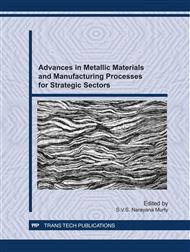p.161
p.167
p.174
p.180
p.186
p.192
p.197
p.203
p.208
Effect of Process Parameters on Splat Formation during Impingement of Liquid Metal Droplets over a Cold Substrate
Abstract:
Molten metal droplet impingement is an integral part of droplet based manufacturing processes like spray casting and sprays coating. In these processes, in a single operation, a liquid metal stream is atomized into fine droplets, which impact on a substrate to form a bulk deposit. The properties of casting or coating strongly depend on the shape of splats formed by individual droplets after impingement and solidification. Therefore, considerable research studies have been carried out to characterize individual droplet impact, usually driven by an interest in a particular process. These studies include extensive modeling of droplet deposition, some of which are supported by experimental studies. Most of these modeling activities have focused on the impingement of a droplet on to a surface to predict quantities such as the extent of maximum spread and the final equilibrium diameter, the rate of heat transfer to the substrate, and the solidification rate. Due to interaction of several complex phenomena, comprehensive modeling of the droplet deposition is a challenging task. The flow of liquid droplet upon impingement is itself a complex phenomenon. Heat transfer and solidification occurring concurrently with the flow adds further to the complexity. Thus the present study aims at the development of a comprehensive mathematical model of impingement of liquid metal droplet upon a substrate to understand the effect of process parameters such as initial temperature of droplet, size of droplet and velocity of droplet.
Info:
Periodical:
Pages:
186-191
Citation:
Online since:
January 2012
Authors:
Keywords:
Price:
Сopyright:
© 2012 Trans Tech Publications Ltd. All Rights Reserved
Share:
Citation:


